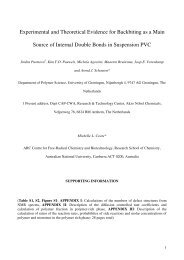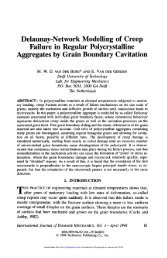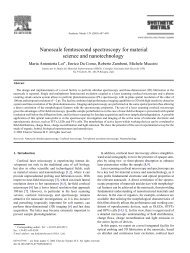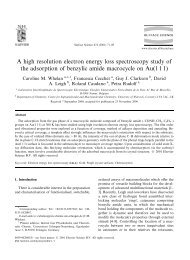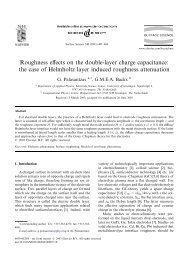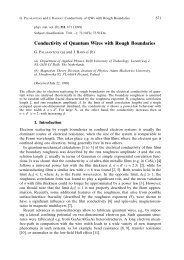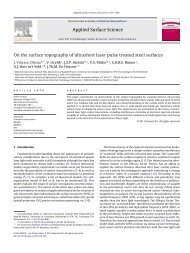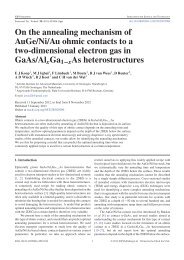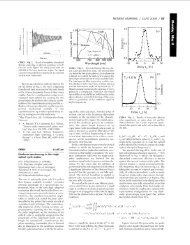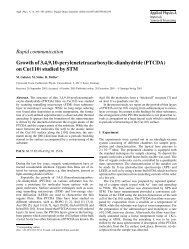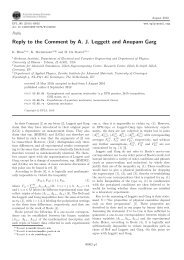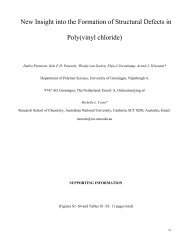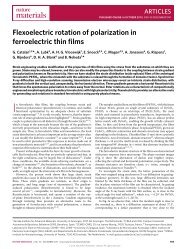Double-layered Aurivillius-type ferroelectrics with magnetic moments
Double-layered Aurivillius-type ferroelectrics with magnetic moments
Double-layered Aurivillius-type ferroelectrics with magnetic moments
You also want an ePaper? Increase the reach of your titles
YUMPU automatically turns print PDFs into web optimized ePapers that Google loves.
A.B. Missyul et al. / Materials Research Bulletin 45 (2010) 546–550 549<br />
Fig. 4. Tilting angle in Bi 2 LnNbTiO 9 . &, axial tilting; ~, equatorial tilting.<br />
Fig. 5. Cationic shift along x axis in Bi 2 LnNbTiO 9 .<br />
lattice parameters, (b a) could be observed for Bi 2 EuNbTiO 9 and<br />
Bi 2 GdNbTiO 9 rather than for Bi 2 NdNbTiO 9 and Bi 2 SmNbTiO 9 and<br />
thus the Curie temperature should increase <strong>with</strong> increasing atomic<br />
number of the lanthanide (Fig. 2).<br />
There are three <strong>type</strong>s of cation positions in the double-<strong>layered</strong><br />
<strong>Aurivillius</strong> phases A 2 A 0 B 2 O 9 . The B-cations possess octahedral<br />
coordination, the A 0 -cations are twelve-fold coordinated (cuboctahedra<br />
A 0 O 12 ) and the A-cations are usually regarded as eight-fold<br />
coordinated (tetragonal antiprism AO 8 ). All coordination polyhedra<br />
are distorted in the low-temperature structure. The most<br />
important changes are discussed in detail below.<br />
The BO 6 octahedra (B = Ti, Nb) are remarkably different from<br />
the ones in the ideal tetragonal structure (Fig. 4, inset). Three <strong>type</strong>s<br />
of the structure changes can be distinguished: the octahedron<br />
rotation and tilting, the off-center shift of the B ion and the<br />
distortion of the oxygen octahedron itself. The B cations move off<br />
center towards a face of the octahedra mostly along the xz<br />
direction. It is clear from the symmetry reasons that the x-<br />
component of this shift determines the ferroelectric displacement<br />
of the <strong>Aurivillius</strong> phases. Rotation of the BO 6 octahedra around z<br />
axis and tilting in the yz plane give an opposite contribution to the<br />
value of the x-component of the B ion shift and compensate each<br />
other <strong>with</strong> respect to a ferroelectric displacement.<br />
The most intriguing is the distortion of the octahedra. The<br />
tilting angle can be determined by two ways. The first one is the<br />
angle between the z axis and the line connecting two axial oxygen<br />
ions. The second one is the angle between the xy plane and the<br />
equatorial plane of the octahedron. (In fact, the four equatorial ions<br />
are not exactly in the same plane, but different possible ways of the<br />
determination of the equatorial tilting do not affect the trend and<br />
almost do not affect values.) While the axial tilting remains almost<br />
constant when the lanthanide changes, the equatorial one<br />
increases significantly when the ionic radius of the lanthanide is<br />
decreased (Fig. 4). This means that axial tilting is determined<br />
mostly by the covalent Bi–O interaction [12] that remains nearly<br />
constant, while the equatorial one depends on the geometrical<br />
factors.<br />
The octahedra distortion acts in such way that the B ion has<br />
more freedom to shift along the x axis (see Table 3). This means<br />
that the compound should become more polar when the Ln radius<br />
is decreased. This does not hold for Bi 2 EuNbTiO 9 where the<br />
direction of the shift is opposite, probably due to more subtle<br />
effects caused by the low spin state of Eu 3+ ion (Fig. 5).<br />
The LnO 12 cuboctahedra are also distorted due to the rotation of<br />
the BO 6 octahedra. The lanthanide ion is moved off center almost<br />
directly along x axis (Table 3). Due to the symmetry reasons the<br />
lanthanide ion remains in the plane formed by the ‘‘O1’’ ions. Like<br />
for B ions, the Ln ions shift increases along the row <strong>with</strong> the<br />
exception of Bi 2 EuNbTiO 9 .<br />
It is interesting to note that the coordination polyhedra of the<br />
Bi 3+ ions change as a result of the structure distortion. Selected Bi–<br />
O interatomic distances are shown in Table 4, including the<br />
distances between Bi 3+ ion and two axial oxygen ions in BO 6<br />
octahedra and the distance between Bi 3+ ion and equatorial oxygen<br />
ion in BO 6 octahedra (note that all Bi–O distances are different).<br />
One can see that the coordination of Bi 3+ changes from eight-fold in<br />
the idealized I4/mmm structure to nine-fold in the distorted<br />
A2 1 am structure. The coordination polyhedron is a capped<br />
tetragonal antiprism (Fig. 6) that is typical for another class of<br />
<strong>layered</strong> structures, namely the Ruddlesden–Popper phases.<br />
Table 3<br />
Selected distortion parameters for Bi 2 LnNbTiO 9 .<br />
Bi 2 NdNbTiO 9 Bi 2 SmNbTiO 9 Bi 2 EuNbTiO 9 Bi 2 GdNbTiO 9<br />
Equatorial tilting angle 8.968 9.988 10.658 14.028<br />
Axial tilting angle 7.588 8.128 6.848 6.958<br />
B ion shift along x axis (Å) 0.0730 0.1203 ( )0.0336 0.3838<br />
Ln ion shift along x axis (Å) 0.0990 0.2344 0.1748 0.3106<br />
Table 4<br />
Interatomic distances (Å) in the BiO 9 polyhedra in Bi 2 LnNbTiO 9 .<br />
Bi 2 NdNbTiO 9 Bi 2 SmNbTiO 9 Bi 2 EuNbTiO 9 Bi 2 GdNbTiO 9<br />
Bi–O2 (1) 3.087 3.027 3.099 3.048<br />
Bi–O2 (2) 3.222 3.194 3.177 3.104<br />
Bi–O5 3.113 2.905 3.098 2.823



